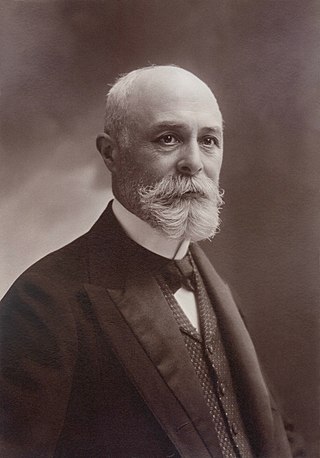
Antoine Henri Becquerel was a French physicist who shared the 1903 Nobel Prize in Physics with Pierre and Marie Curie for his discovery of radioactivity. The SI unit of radioactivity, the becquerel (Bq), is named after him.

Crater Lake is a volcanic crater lake in south-central Oregon in the Western United States. It is the main feature of Crater Lake National Park and is famous for its deep blue color and water clarity. The lake partly fills a 2,148-foot-deep (655 m) caldera that was formed around 7,700 years ago by the collapse of the volcano Mount Mazama. No rivers flow into or out of the lake; the evaporation is compensated for by rain and snowfall at a rate such that the total amount of water is replaced every 150 years. With a depth of 1,949 feet (594 m), the lake is the deepest in the United States. In the world, it ranks tenth for maximum depth, as well as third for mean (average) depth.

Henri Victor Regnault was a French chemist and physicist best known for his careful measurements of the thermal properties of gases. He was an early thermodynamicist and was mentor to William Thomson in the late 1840s. He never used his first given name, and was known throughout his lifetime as Victor Regnault.
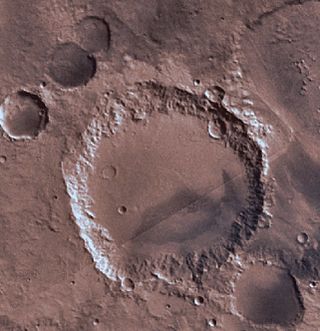
Beer is a crater lying situated within the Margaritifer Sinus quadrangle (MC-19) region of the planet Mars, named in honor of the German astronomer, Wilhelm Beer. It is located at 14.4°S 351.8°E.

The far side of the Moon is the lunar hemisphere that always faces away from Earth, opposite to the near side, because of synchronous rotation in the Moon's orbit. Compared to the near side, the far side's terrain is rugged, with a multitude of impact craters and relatively few flat and dark lunar maria ("seas"), giving it an appearance closer to other barren places in the Solar System such as Mercury and Callisto. It has one of the largest craters in the Solar System, the South Pole–Aitken basin. The hemisphere has sometimes been called the "Dark side of the Moon", where "dark" means "unknown" instead of "lacking sunlight" – each location on the Moon experiences two weeks of sunlight while the opposite location experiences night.

Apollo, also called the Apollo basin, is a large impact crater located on the far side of the Moon, in the southern hemisphere. It was previously known as Basin XVI; in 1970 it was officially named after the Apollo missions by the International Astronomical Union.
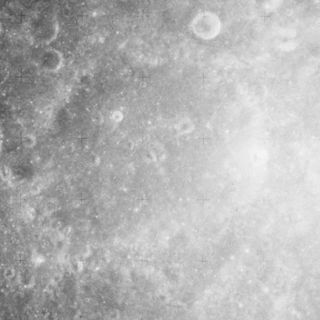
Buisson is a lunar impact crater that is located on the far side of the Moon. It is named after the French physicist Henri Buisson. Nearly attached to the southeast rim is the crater Vesalius. To the southwest is Einthoven. The rim of this crater is somewhat worn, and is lowest in the north. There is a low central ridge across the midpoint.

Focas is a small lunar impact crater that lies on the far side of the Moon, just past the southwestern limb. In this location the crater is occasionally brought into view due to libration, but not much detail can be seen because the crater is viewed from the side.

Chrétien is a lunar impact crater that is located in the southern hemisphere on the far side of the Moon from the Earth. It lies due south of the Mare Ingenii, one of the few maria on the Moon's far side. The crater lies in the midpoint between the craters Garavito to the west-southwest and Oresme to the east-northeast, both of these being somewhat smaller than Chrétien.
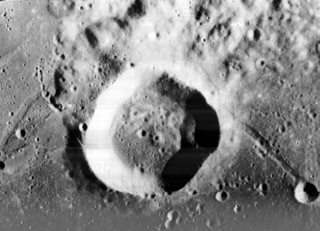
Lunar craters are impact craters on Earth's Moon. The Moon's surface has many craters, all of which were formed by impacts. The International Astronomical Union currently recognizes 9,137 craters, of which 1,675 have been dated.

Erebus is a crater lying situated within the Margaritifer Sinus quadrangle (MC-19) region of the planet Mars, this extraterrestrial geological feature was visited by the Opportunity rover on the way to the much larger crater Victoria. It is named after the polar exploration vessel HMS Erebus which was used by James Clark Ross in 1841 to discover the Great Ice Barrier, now known as the Ross Ice Shelf. The rover was in the immediate vicinity of the crater from approximately sol 550 to 750.

Koga is an impact crater on Mars, approximately 19 kilometers in diameter. It is located at 29.3°S, 103.8°W, north of the crater Virrat and northeast of the crater Dinorwic. To the north is the crater Nhill. It is named after a town in Tanzania, and its name was approved by the International Astronomical Union in 1991. According to a surface age map of Mars based on US Geological Survey data, the area around Koga is from the Noachian epoch, which places the area's age at 3.8 to 3.5 billion years ago. Sharp blocks and cliffs poke through a mantle of fine material located at the bottom of the crater. At the deepest part of the crater, it is about 5,200 meters in elevation above zero altitude, and its rim averages about 6,400 meters above zero altitude. It is therefore approximately 1.2 kilometers deep.

Matisse is an impact crater on the southern hemisphere of Mercury. Matisse takes its name from the French artist Henri Matisse, and it was named by the IAU in 1976.

Derain is a crater on Mercury named after André Derain, a French artist, painter, sculptor and co-founder of Fauvism with Henri Matisse. It has uncommonly dark material within and surrounding the crater. The material is darker than the neighboring terrain such that this crater is easily identified even in a distant global image of Mercury. The dark halo may be material with a mineralogical composition different from the majority of Mercury's visible surface. Craters with similar dark material on or near their rims were seen on the floor of the Caloris basin during MESSENGER’s first flyby.
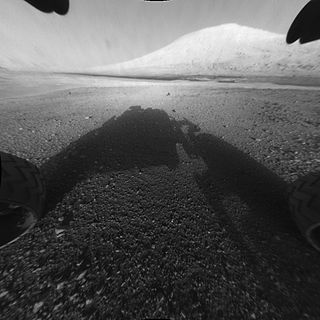
Mount Sharp, officially Aeolis Mons, is a mountain on Mars. It forms the central peak within Gale crater and is located around 5.08°S 137.85°E, rising 5.5 km (18,000 ft) high from the valley floor. Its ID in the United States Geological Survey's Gazetteer of Planetary Nomenclature is 15000.

Anguissola is a crater on Mercury. It has a diameter of 35.41 kilometres. Its name was adopted by the International Astronomical Union (IAU) on August 4, 2017. Anguissola is named for the Italian painter Sofonisba Anguissola.
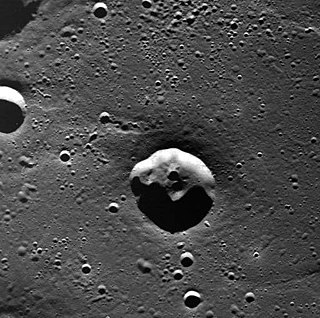
Anyte is a crater on Mercury. It has a diameter of 20.92 kilometres. Its name was adopted by the International Astronomical Union (IAU) on August 4, 2017. Anyte is named for the Greek poet Anyte of Tegea.

















